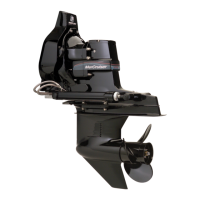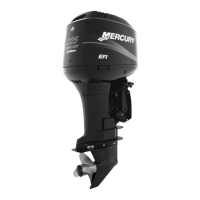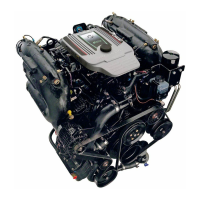!
CAUTION
Seawater leaking from the seawater strainer could cause excess water in the bilge, damaging the engine or causing the boat
to sink. Do not overtighten the cover screws, or the cover may warp and introduce seawater into the bilge.
7. Install the seal and cover using the screws and washers. Do not overtighten the cover screws.
a - Screws and washers
b - Cover with glass
c - Strainer
d - Housing
e - Drain plug and sealing washer
f - Seal
8. Open the seacock, if equipped, or remove the plug and reconnect the seawater inlet hose.
9. Upon first starting the engine, check for leaks or air in the system that would indicate an external leak.
Corrosion Protection
General Information
When two or more dissimilar metals are submerged in a conductive solution of saltwater, polluted water, or water with a high
mineral content, a chemical reaction takes place causing electrical current to flow between metals. The electrical current flow
causes the metal that is most chemically active, or anodic, to erode. This erosion is known as galvanic corrosion and, if it is not
controlled, it will eventually cause the need for replacement of power package components exposed to water.
To help control the effects of galvanic corrosion, Mercury Diesel power packages come with several sacrificial anodes and
other corrosion protection devices. For a more comprehensive explanation of corrosion and corrosion protection refer to the
Marine Corrosion Protection Guide.
IMPORTANT: Replace sacrificial anodes if they are eroded 50% or more. Mercury Diesel strongly recommends avoiding the
use of anodes from other manufacturers. Refer to your Mercury Diesel–authorized repair facility for additional information.
Engine Corrosion Protection Components
The engine is equipped with a sacrificial anode located on the intercooler end cover to assist in protecting the engine and the
seawater cooling system from corrosion.
Removal
1. Allow the engine to cool.
NOTICE
Failure to close the seawater inlet or seacock when removing or replacing the anode plugs can lead to water damage. Close
the seacock or remove and plug the seawater inlet hose to prevent water from entering the anode plug holes.
2. With the engine off, close the seacock, if equipped, or remove and plug the seawater inlet hose.
3.
Drain the seawater system. Refer to Flushing and Draining the Seawater System.
a
b
c
d
e
f
12863
Section 4 - Maintenance
Page 50 90-8M0133568 eng JUNE 2017
